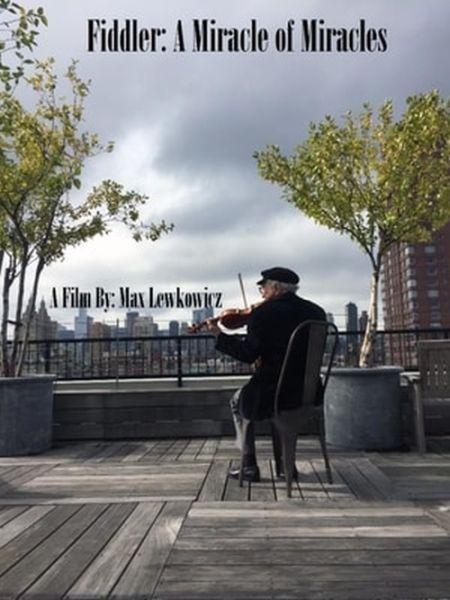Fiddler on the Roof has received 9 Tonys, has been the most running musical in Broadway history and is being played every single day somewhere in the world since 1964, like no other play ever.
By Tsipi Inberg Ben-Haim
“Fiddler: A Miracle of Miracles” is a Masterpiece of a documentary that used creativity, wisdom, knowledge and above all the understanding of the human soul, like very few other documentaries I have seen before. Directed by Max Lewkowicz, executive producer-Patti Kenner, it’s a must-see film.
One might say; well, after all, this play – Fiddler on the Roof, has received 9 Tonys, has been the most running musical in Broadway history and is being played every single day somewhere in the world since 1964, like no other play ever. We see clips from the play in different countries in several languages.
So what is it about Fiddler on the roof that captivates our hearts and attention?
I posed my questions to a few people, of very many, that are responsible for creating this Masterpiece as well as guests at the screening organized by Patti Kenner;
TBH – The play “Fiddler on the Roof “, first came on a Broadway stage in 1964, based on the Shalom Aleichem story-Tevya the Dairyman, and played by Zero Mostel. Is it a Jewish play?”
Tanya: No, it’s not just Jewish. It belongs to us all. When Lin-Manuel Miranda, who is of Puerto Rican descent, got married to his wife, Vanessa, who is Dominican, he and his new in-laws surprised her with a song he had rehearsed and choreographed. The song was not Latin or Hispanic in origin, but Jewish: “To Life,” from “Fiddler on the Roof.”
TBH – The creative process of searching, selecting and putting together this amazing archival footage must have been lengthy and not easy. Can you tell us about this decision-making process?
Patti & Max: It took over two years to put this documentary together. Many moving parts had to be researched and placed together.
TBH – No dought that having Lin-Manuel Miranda, in the cast, brings this documentary to contemporary times. Were you surprised to see him?
David: Yes, completely unexpected. Since he’s the creator of the most popular play today on Broadway-Hamilton.
However, the minute he talked about himself as a kid playing in Fiddler in his school play, he was so convincing you felt that the play touched him throughout his life so much that when he got married 10 years ago the song TO LIFE became a central piece in his wedding.
TBH – Why do you think this documentary was created now?
Patti: Jack Kliger, the President, and CEO of the museum of Jewish Heritage-Battery Place New York City, asked me over 2 years ago if I would like to do a documentary about Fiddler?
I immediately said YES! and got to work. Very many people helped with sponsoring this beautiful documentary. Their names are listed at the end of the movie. I would like everyone to know who helped.
I also want to make sure that as many seniors as possible can see this documentary especially those who can’t afford to buy a ticket.
I invite groups of them for special screenings.
Jack Kliger: Nowadays, when we see what’s going on around us and what hate can do to people,
Fiddler’s story must be told again and again. At the Museum of the Jewish Heritage we’re showing now: Auschwitz-Not Long ago, Not Far away…
Bel Kaufman,102, Shalom Aleichem’s Grand-daughter, Writes E-books Now
TBH – While amazing documentary “Fiddler: A Miracle of Miracles” teaching us a lot about the history of the Jews and emphasizing the fact that Jews were forced to leave, they were fleeing POGROMS. They didn’t leave their homeland countries because they were looking for a better economical life somewhere else… However, there is a part of the film that seems loaded politically.
Making an analogy between the Holocaust and the POGROMS to present times, immigrants to the USA. What was behind this thinking?
Shula Bahat: (CEO Beit Hatfutsot of America) The most compelling feature of Shalom Aleichem’s story of Tevye the Dairyman, otherwise known as Fiddler on the Roof, is its personal and universal resonance. Every person can find her/his experience or part of it, in the story writ-large, of Tevye and his family as presented in literature, film, in music and dance.
For me, the importance of the story is in its humanity, not partisanship. Alas, if some people can find lessons and empathy within the unique Jewish experience, in the fact many Jews left their birthplace because of persecution, antisemitism which often limited their economic opportunities, so be it.
TBH– Inserting creative graphics, cartoons, and art into the film lifts audiences up from the heavy, painful events that are conquering their minds and hearts. What do you think?
Amnon: A unique untraditional way that helps the documentary, which has so much talking going on…
Releases tension with beautiful graphics while connecting the pieces of the play, presented in different places around the world, to come together. It adds a fresh visual perspective to the verbal statements.
TBH -We’re told that since 1964 Fiddler has been shown every day at least one time, somewhere around the world. Any educational plans are being discussed?
Patti: These days “Fiddler Miracle of Miracles” is shown in 127 theaters around the US. According to Jack Kliger, the Museum of Jewish Heritage is working on educational plans to have children benefit from this historical documentary.
I interviewed the granddaughter of Shalom Aleichem Bell Kaufman she was 102 years old, at the time. I asked her;” what could you tell me about Shalom Aleichem that people don’t know about him”? she said; “He made people laugh but he was a very sad man.”
It may explain how Pogrom and suffering can become an entertaining musical. Especially when Tyvia the Dairyman is acted by Haim Topol.
Whose expressive sparkling eyes and demanding voice bring us to tears and laughter at the same time.
In the documentary, he reflects back on playing Tevye and tells us with a giggling voice on the 3 days toothache he had while filming painfull/happy scenes in Anatevka!
Read more about: Bell Kaufman, documentary Fiddler: A Miracle of Miracles, Fiddler on the Roof, Shalom Aleichem




